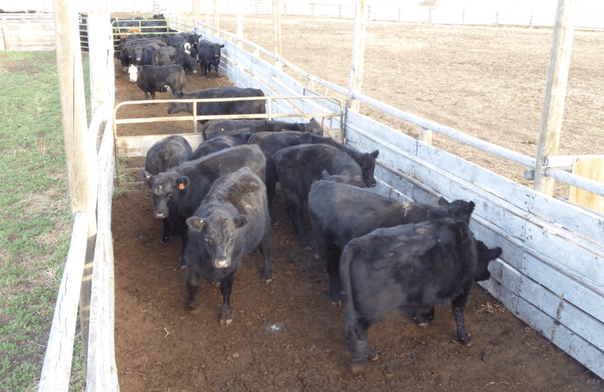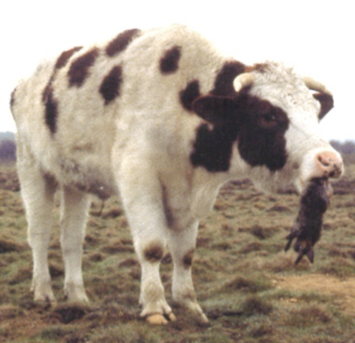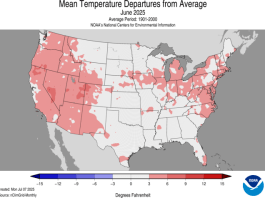This piece comes to us from Whit Hibbard and Dawn Hnatow. In their first piece in this pen-working series, they described how to move cattle into a corral, how to empty pens from the front and the back, and how to get cattle out of a corner. Now, we move on to what to do once cattle are in alleyways. As always, the emphasis is on low-stress for both people and animals.
Alleyways
Conventionally, alleyways are used not only for livestock movement, but for storage. From the low-stress perspective, however, this is very hard on animals and will unnecessarily hurt performance. Cattle don’t like to be crowded to the point that they bump into each other. Their anxiety and stress levels go way up, and they become less cooperative because all they want to do is go back to the last place they were comfortable. The situation is aggravated if we go in from the front to peel off a draft to take to the next step. This makes all the animals crowd to the back of the alley which puts immense pressure on those already in the back. comfortable. This makes the whole corral experience bad which makes those cattle harder to work the next time.
Ideally we should store our animals in corrals/pens and bring out drafts as described in Part 1 and only use the alleyway for transport. However, if we do use our alleyways for storage there are several things that we can do to make it less stressful on the animals. First, we can give them plenty of room by putting fewer in a section. These cattle are being stored in segments of the alleyway, waiting their turn to go up to the processing area for pregnancy testing. Note the generous space they are given to keep them relaxed and in a normal frame of mind. In this regard, wider alleyways are better (i.e., 14′-16′) instead of 12′ (pictured here).

Another thing we can do is put a person at the end of the alleyway to keep the animals from pressing up against the back. That way, as the handler comes to peel off another draft, the cattle will be facing forward so the handler can walk against the animals along the fence. This is the reverse parallel walk that works so well to get animals to walk forward past the handler. The person in back (with the aid of a flag, if necessary) keeps the animals facing forward, stopping them from going to the back of the alley whenever the handler approaches.

One person driving cattle up an alleyway
 Conventionally, how do people drive cattle up an alleyway? They generally fall in directly behind them and push (often with the aid of noise, stock whips, flags or paddles to scare the animals up the alleyway). But pushing on cattle from directly behind has several negative consequences: (a) they don’t like it because we’re in their blind spot; (b) they turn their heads or bodies to keep track of where we are so they’re not moving ahead like they should and not driving the ones in front of them like they should. If we continually apply pressure from directly behind, some animals may even break back towards us to relieve the pressure.
Conventionally, how do people drive cattle up an alleyway? They generally fall in directly behind them and push (often with the aid of noise, stock whips, flags or paddles to scare the animals up the alleyway). But pushing on cattle from directly behind has several negative consequences: (a) they don’t like it because we’re in their blind spot; (b) they turn their heads or bodies to keep track of where we are so they’re not moving ahead like they should and not driving the ones in front of them like they should. If we continually apply pressure from directly behind, some animals may even break back towards us to relieve the pressure.
To solve these problems, simply use the forward-angled zigzag. Whether on foot or horseback, if you zigzag behind the middle part of the bunch, animals can see just enough of you that they’ll keep moving forward.

Two people driving cattle up an alleyway
If there are two people driving animals up an alleyway they should each stay close to the fence and zigzag behind the cattle in front of them. That keeps the animals going straight down the alleyway and not wanting to turn back (see Figure 4).

 Working alleyways from the outside
Working alleyways from the outside
Another way to effectively move cattle up an alleyway is to walk or ride reverse-parallel on the outside of the alleyway. (Attempting this inside an alleyway is too much pressure for most animals.) As you pass each animal’s balance point it should speed up in the direction it’s going. If you need to repeat, it’s important to make the triangular return.
If animals stall out
 An effective way to resume movement in animals that are stalled out in an alleyway is the “rocking” technique, in which you literally rock back and forth. This applies a surprising amount of pressure on animals and drives them ahead.
An effective way to resume movement in animals that are stalled out in an alleyway is the “rocking” technique, in which you literally rock back and forth. This applies a surprising amount of pressure on animals and drives them ahead.
When using this technique, give the animals time to begin moving ahead. It can takes some time for the movement to domino through the herd all the way to the front. Once it does and the herd starts moving, advance with the herd keeping the same distance between you. At some point when the herd really begins to move out you will transition to the zigzag.
Stopping animals that break back
Whenever an animal breaks back on us, it’s because of something we did. We may have over-pressured it, or we might have been out of position. Under excess pressure animals want to go back where they came from. If you jump in front of it, that only increases the pressure and it’s urge to run.
The better response is to back up a step or two. That instantly releases pressure on the animal and it will almost always stop, reconsider, and turn back to its mates.
Stopping animals that are coming at you
To stop animals in an alleyway that are coming towards you, rock back and forth, and back up if necessary. Our tendency is to go directly at them, but that actually tells them to go by you because it’s a reverse-parallel movement.
Conclusion
Corral work can be a highly stressful time for us and for our cattle. We hope these tips will help you reduce your stress and theirs. If you have questions for us, do share them in the comments below and we’ll get back to you!





Good article on stock. Thanks for publishing it.
Comments are closed.